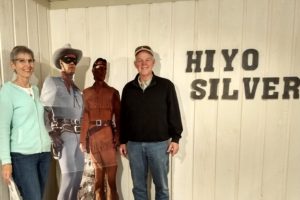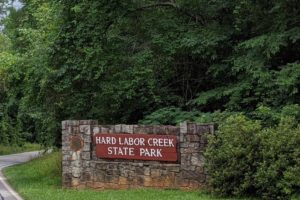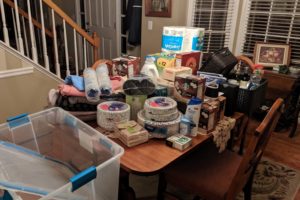Becoming a territory in 1861 and then a state in 1889 formalized the status of North Dakota. Unable to figure out a capital location that would satisfy everyone, the territory was split in 2, and on November 2, 1889, we ended up with North and South Dakota. President Harrison had the papers shuffled to obscure which statehood one was signed first, and the order went unrecorded.

governmental history of this area (from Wikipedia)
The Dakota Territory consisted of the northernmost part of land acquired in the Louisiana Purchase in 1803, as well as the southernmost part of Rupert’s Land (just north of where we are), which was acquired in 1818 from Canada when the boundary was changed to the 49th parallel. The name refers to the Dakota branch of the Sioux tribes which occupied the area at the time. Most of Dakota Territory was formerly part of the Minnesota and Nebraska territories.
When Minnesota became a state in 1858, the leftover area between the Missouri River and Minnesota’s western boundary was unorganized. When the Yankton Treaty was signed later that year, ceding much of what had been Sioux Indian land to the U.S. Government, early settlers formed an unofficial provisional government and unsuccessfully lobbied for United States territory status.
Three years later President-elect Abraham Lincoln’s cousin-in-law J.B.S. Todd personally lobbied for territory status, and the U.S. Congress formally created Dakota Territory. It became an organized territory on March 2, 1861, and included much of present-day Montana and Wyoming, as well as all of present-day North Dakota and South Dakota and a small portion of present-day Nebraska.
A small patch of land known as “Lost Dakota” existed as a remote exclave of Dakota Territory until it became part of Montana Territory in 1873. It had been about 11 square miles and was located at the tripoint between the current states of Idaho, Wyoming, and Montana.
Other land was transferred to Nebraska in 1882.
government and statehood


The railroads, banks, and companies buying grain had a great deal of influence over the prices farmers received for their produce, as well as the shipping costs to get to market. Price control by the elevators, railroads, and banks created a problem for the farmers. In the 1880s the farmers organized a Farmer’s Alliance that had radical and socialistic tendencies. Then came the Populists, progressive, and equity movements that brought some reforms.
Early local offices were usually held by Anglo-Americans or Anglo-Ontarians who understood the American system of laws and spoke English, giving them the confidence to assume leadership roles.



many came to farm


In the early years, farming involved the entire family as they lived at the job, on the job, and with the job 24 hours a day. They were lucky if they had a pair of oxen and a plow since they had very little cash until the first crop was harvested.
As new settlers cultivated more land, they needed more and larger equipment. Only large farmers could afford their own threshing machine. Small farmers had to rely on neighbors with machines or on custom threshers. The charge for threshing was computed by the hour or by the bushel.
At harvest time, the settlers organized to help each other out with horses, drivers, grain wagons, and bundle racks as they moved from one farm to another. Muscle power did all the lifting, pushing, and pulling in the early years. From women we talked to who lived here, farmers still help each other during harvest time.
Farmers readily adapted to new and better methods of farming and to new and larger pieces of equipment as they became available.

The sod had to be turned to expose roots of the prairie grasses so they could dry and the plants could die. But one turning of the sod wasn’t enough. In the fall, a new field was plowed a 2nd time. Remaining roots would be exposed to the weather to be killed. Plowing cross-ways to the original breaking served this purpose. When spring came, the farmer found an excellent seed bed ready for whatever crop he wanted to raise.

bottom: breaking sod with oxen = 1 acre a day

A prairie fire 5 miles wide came toward the farm, “burning everything not protected by the breaking. Ordinary firebreaks didn’t stop the rolls of fire that would jump for rods catching stubble, grass, or stacks beyond.”


bottom: haying time in 1909
I had never heard of a self-binder so had to look it up. Per Encyclopedia Britannica , a binder machine was used for “cutting grain and binding it into bundles, . . . such as wheat. The first patent was issued on a self-tie binder in 1850. The horse-drawn twine binder, first marketed in 1880, remained the chief method of harvesting small grain during the early decades of the 20th century. The mechanical twine knotter was patented in 1892 in the United States. Along with the header, which cut off the heads of grain and elevated them into a wagon for later threshing, the binder was standard harvesting equipment in the wheat-producing areas of the United States and Canada until the grain combine was adopted in the 1930s. Binders, using twine, not wire, were still used in the late 20th century to a limited extent on small farms.” Interesting.


right: a cook car and often a bunk house car (sleeping quarters for the crew) followed the threshing machine.

right: a haystacker in 1919


right: plowing and harrowing using a steam engine; this 8-man crew could cover 40 acres a day

right: Old Main college building at the Ag College in Fargo; students here worked on developing better seed that would be resistant to disease, mature earlier, and yield a larger crop. Farmers were glad to see these improvements.
getting around


With no sidewalk, no pavement, and nothing but a dirt road with mud like rubber that would pile up on your feet until they were so big and heavy, making walking almost impossible.

bottom: a ferry on the Red River in 1907

right: a Red River cart in front of the Pembina Hotel
bottom: a dog sled

Such a man was Mohammed Bomrod, a Syrian. He started with a pack on his back and visited farms selling his wares. He became very popular with his customers since he carried what they usually needed. Often families would offer him a bed and a meal.

middle: a woman drive a buggy with a pair of horses
bottom: men driving their cart with a pair of oxen

bottom: a cart and horse from that time

changing times



The basement dirt had been hauled out with a tumble bug dirt scraper. What is that? It’s a poor man’s dirt mover and leveler. Think of a large barrel with a slice taken out of it, laying on its side. The hitch attaches to the ends.
The brick was made elsewhere in ND. Unusual for the time, the house had electricity powered by a Delco battery system stored in the basement. It also had a water and sewer system that supported an upstairs bathroom with a clawfoot bathtub. A cistern to store rain water was part of the basement, and more water storage was in the attic. A wood and coal furnace heated the house.

Here are some more innovations in this home:
- A built-in china closet opened from the pantry into the dining room.
- The first floor had 3 stained glass windows: 1 in the dining room and 2 in the living room.
- Oak floors and woodwork
- In the dining room, a plate shelf displayed special china.
- The front porch had an upstairs porch over it.
- The upstairs door had an etched picture of President McKinley in the glass.
- A wood shed on the north side of the house was also used as a summer kitchen to keep the rest of the house cooler.
- All the boys slept in 1 room, and grooves were worn in the wooden floor from the beds being moved around.
- Only 1 closet was installed upstairs under the steps to the attic. I think closets were taxed as a separate rooms, so most families didn’t have many.
- The attic was used for hanging clothes to dry in the winter, for storage, and as a place for the children to play.
- The house also had a back stairway leading from the kitchen upstairs.
- The open main stairway had an oak banister for the children to slide on (family-friendly home).
- Sliding doors were used in the living room, and swinging doors were used between other downstairs rooms.
- At one time the house was home to 4 generations.
This was quite a home! Other fine homes were being built in this area of the state, but we weren’t given information about them.


Early telephones were powered by 2 batteries that quickly lost their charge. When a common battery was invented, telephone companies could have central exchanges and switchboards. The “central” operator was usually a woman, and she knew everyone’s business. She gave out the correct time, the weather forecast, market quotations, and call the fire department when necessary. Maintenance was expensive, and during the Depression, few farmers could afford this luxury.



Daily grain price quotations from the principal world markets came in by telegraph, so grain buyers began to ship substantial quantities of wheat into national and international channels. The source of world news for local newspapers also came through the telegraph. And it was used by settlers to send and receive messages to distant relatives and friends.
horseless carriage


Automobiles brought the need for better roads and new services in town: the gas station, parking lot, auto mechanic, and auto salesman. Eventually livery barns and related businesses disappeared. As settlers could easily travel to larger towns, such small town specialty shops as the millinery store were forced to close.





rural mail delivery




going to town


As improvements to transportation, roads, and communication came to the state, the small town began to be replaced by the larger, more distant city. By 1920, a number of small towns had already disappeared.

right: Winter travel was done using sleighs with 1 set of runners and bobsleds with 2 sets of runners.
bottom: Summer travel could be done by a family using a 2-seat buggy.


right: Carnegie Library in the town of Grafton
Women’s clubs organized and maintained many of the early libraries in the 1900s in the towns we’ve talked about. In 1889, a Literary Society at Pembina started an Icelandic Library with 20 charter members. Eventually the library had 600 books. More libraries were started in other communities once settlement began.



right: an ice cream parlor where an ice cream soda sold for $.05 (around $1 today)
then and now


Those who liked life the way it had been moved further west. Those who stayed melted together to make a new and vibrant civilization. They had withstood the harshness of the climate and the rigors of pioneer life by building schools, churches, and homes.
notable women


right: Beulah Amidon studied law and fought for the women’s vote to the point that she was arrested for picketing in 1917.

right: Corene Vaughn was the 1st woman to serve as a county commissioner in Pembina County starting in 1992 and served for 20 years.
We’ll see more about women who helped build ND in the next museum we’ll go to.
right to vote





prairies of the past

Fire (from lightning strikes or Native American tribes setting fires) kept down the number of woody shrubs and trees, returning minerals and nutrients to the soil. A management strategy that’s good to know.
You would have seen bison, deer, and elk grazing in large numbers. Their foraging also helped keep the shrubs down, and their hooves aerated the prairie soil, so new plants could sprout each year. Their grazing also helped fertilize the soil with their waste.


What is pemmican? Per Wikipedia it’s “a mixture of tallow, dried meat and dried berries used as a nutritious food. Historically, it was an important part of indigenous cuisine in certain parts of North America, and is still prepared today.”
paths through the prairie
Prairie was the dominant habitat in ND, especially in the area we’re in. Of the 3 types of prairie—shortgrass, mixed-grass, and tallgrass—only the latter 2 exist where we are.

Transitional mixed-grass prairie areas contain some tallgrass species, along with other shortgrass species common to the SW corner of the state. Regardless of the type of prairie, these grasslands are all rich in varied species of plants, animals, and insects (mosquitoes!).

Bird droppings help spread the prairie plants’ seeds. Smaller animals like gophers and badgers burrow beneath the grasslands to bring oxygen and water to plant roots so they can thrive. Larger animals like bison, elk, and deer bite off the tops of prairie plants as they graze, encouraging new growth. All animals fertilize the soil with their waste.






Tough steel plows that cut through the sturdy (and deep) roots of prairie plants, new wheat varieties, improved flour milling techniques, and railroad transportation made it possible for settlers in this area to produce crops for market.
The unintended consequences of economic success, however, was the disappearance of diverse plants and the habitats of animals.


This disaster in the 1930s led to changes to transform the landscape. Today we can see miles of green trees planted in shelterbelts between fields or windbreaks near farm buildings. These shelterbelts reduced windblown soil erosion and heating costs and created wildlife habitat for many birds and animals.


We’ve made it to the end of this museum at the Icelandic State Park. So informative! The next post will take us to the Pembina County Museum across the highway from the park.
Both of these museums showed us how much the people in this state love living here.




